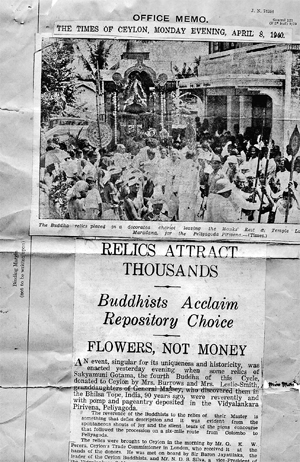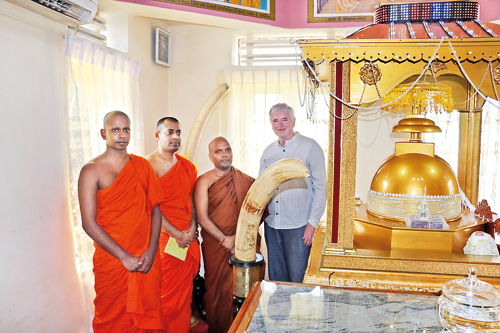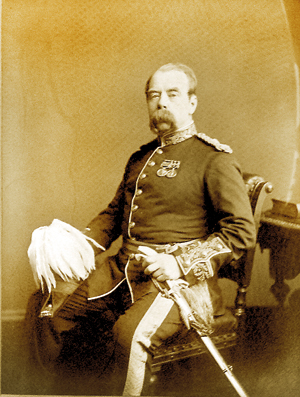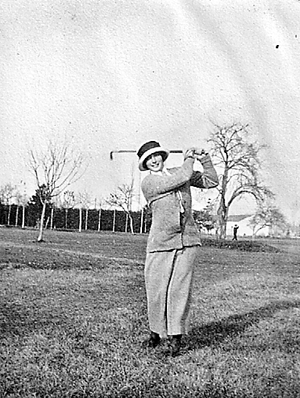Sacred Relics: from Britain to then Ceylon

How The Times of Ceylon reported the arrival of the Relics
Rummaging through his late great aunt’s attic in Waxway Cottage deep in Devon, Nick Gilbey was arrested by a paper cutting and a letter from 1940- two documents that pulled him away from the English countryside setting, reminding him of the strong connection his family had had with the East, in particular with India, at the time Victoria was Empress of that subcontinent, and also, much later, Ceylon- the ‘crown jewel’ of the British Empire.
The paper cutting was from The Times, the most respected of British dailies. It spoke about how, in that year almost eight decades ago, Nick’s grandmother Ethel Leslie-Smith and his great aunt Winifred Burrows had gifted to Ceylon the Sacred Bone Relics found in 1851 in Sanchi by Nick’s great-great grandfather- Frederick Charles Maisey.
The letter, dated around the same time, was from the Governor of Ceylon Sir Andrew Caldecott, a cordial epistle of thanks to the two sisters where that great British administrator had enclosed more paper cuttings for them, these from The Times of Ceylon and other local broadsheets describing the welcoming of the Relics.
Wrote Sir Caldecott to Winifred Burrows, “(your gift of relics) is valued so highly that all the big temples in the island have clamoured for it.” For this was no ordinary Relic. As the man who unearthed them with their translucent crystal casket, General Frederick Maisey, believed firmly, these were remains of none other than the Buddha.
Yet who was General Maisey, and how did he come across that beautiful casket and the sacred treasure concealed therein?
Son of renowned artist Thomas Maisey, Frederick was himself an artist with a distinctive flair. But while the father painted rustic English scenes, the son was destined to capture, more memorably, Indian antiquities half clothed by wilderness. Having gone to India in 1842 to become an ensign in the Bengal Native Infantry, Maisey was an ardent antiquarian in love with the vestiges of ancient India that Englishmen were then discovering.
Maisey was best known for his archaeological work with Sir Alexander Cunningham in Sanchi- the most ancient of Buddhist sites in India. It was in Bhojpur, a site near the famous great Sanchi stupa, that Maisey discovered these relics.
Bhojpur has some 60 stupas, in a fortified rocky hilltop where the wind howls over yellow grass and dry bush. It was the large mound christened the ‘Bhojpur Stupa 2’ that yielded the Relic casket. Described as ‘the most curious and costly of all the discoveries’ made there, it contained three small pieces of bone each about 10mm long, and ‘seven precious things’ as the British Times grandly put it. These were “thin round pieces of gold, a bead of garnet, a crystal bead, two beads of pale greenish crystal and some minute fragments of pearl’.

Nick Gilbey in the shrine room with monks of the Vidyalankara Pirivena
Finders not being keepers, Maisey had to hand over the discoveries on the site to the Victoria and Albert Museum in London in 1856. But he managed to retain the objects enshrined within the reliquary. The museum was content with the miniature masterpiece of crystal rock casket, while Maisey, with his deep interest in Buddhism, was delighted to retain what he doubtless knew was the real treasure- objects pulsating with sacred and historical significance.
The General’s firm conviction was that the tiny Bone Relics were of the Buddha. Not only were they discovered in the womb of the most perfectly shaped stupa in the area, but the casket was the most exquisite and ornate to be discovered. But the most sound of his arguments is that it had no inscription- and only the name of the Buddha was then considered too sacred to be put down; designations of any other personage, lay or clerical, could be inscribed on the reliquary.
The General passed away in 1892, and his lifelong labour of love, ‘Sanchi and its Remains’, was published posthumously the year after. The Relics were handed down to his son- Colonel Maisey- and through him later to the sisters Mrs. Leslie- Smith and Mrs. Burrows.
So much for the Victorian part of that saga. The newspaper cutting that Nick held in his hands in the Devon attic spoke of the next episode happening in the 1930s. It reported that his grandmother had been in Ceylon- which was news to Nick.

General Frederick Maisey
He was, however, then able to piece the story together with the help of a postcard sent by the grandmother to the Burrows great-aunt while on the way to Australia by ship. On that journey Mrs. Leslie-Smith and her friend, Maddie Henderson, had called at Colombo.
It was here that she had met a Buddhist monk (Nick believes from the Gangaramaya temple), who, learning about the great treasure in the care of the two sisters, had enlightened her on how highly such objects would be venerated within the island.
So, in 1940, the two generous women did the best they could and provided the island with a Relic, supposedly of the Teacher held most supreme there. The Times article speaks of a silver ‘tope’ (stupa) being specially made for the occasion.
It was welcomed with grand processions and was taken amidst peraheras to the Vidyalankara Pirivena temple in Peliyagoda- chosen as home for the Relic by Sir Baron Jayatilaka, ‘leader of Ceylon Buddhists’.
Nick, now having put together this family puzzle more or less as an armchair adventurer, wanted to add his own piece. Would he be able to find, in the island now renamed Sri Lanka, memories of the two English ladies, and what they donated?
Travelling to Sri Lanka this April, he found his kith and kin not only remembered, but also thanked, each evening, in the chants recited in the special shrine in the temple. The monks have incorporated the name of Winifred Burrows into the evening worship- and sung her praises for the past 80 years. The warm welcome Nick was accorded would have made up for the fact that he was not able to view the Relic, or the golden and silver caskets it is housed in, these being displayed only during the ceremony in December when devotees queue up to worship.
Part of Nick’s quest was accomplished- having seen the relics associated for so long with his family, safely enshrined in a place where it is the sanctum sanctorum. Yet another object, much valued for its academic lustre, is however, lost in limbo- the diary of General Maisey which for some reason accompanied the Relics to Colombo, from where it disappears from record.
All the late antiquarian’s diaries are held at the British Library in London, save this particular precious volume, written at the time of the discoveries at Sanchi. The British Museum as well as the Victoria & Albert would have coveted photographs of this invaluable record, yet Nick could not provide these institutions with positive tidings following his trip to Sri Lanka. Perchance- it is another quest awaiting him.
| Mrs. Burrows still remembered with gratitude | |
 Winifred Burrows The Vidyalankara Pirivena, Peliyagoda, where the Relics are enshrined and venerated, is one of the largest seats of monastic learning in the island, with a history of nearly 150 years. Sir Baron Jayatilaka selected this temple, from amidst the many shrines that competed for the honour, because the temple accepts no sammadan (money in any form including collection boxes). Flowers and food are the only alms received there. Director of the Pirivena, Ven. Welamitiyawe Kusaladhamma Nayaka Thera, Chief Sanghanayake for Colombo and Chilaw provinces and Chancellor, University of Kelaniya, said that the Relics are worshipped daily with thevava services in the morning and the evening, just as happens at the Kandy Dalada Maligawa. Each December, the Sacred Relics are displayed in their three-storeyed shrine for a selected number of days, in the evening from 5 to 8. The Prelate spoke with warmth of Nick Gilbey’s visit, as grand-nephew of Mrs. Burrows, still remembered with gratitude in the central shrine.
|


